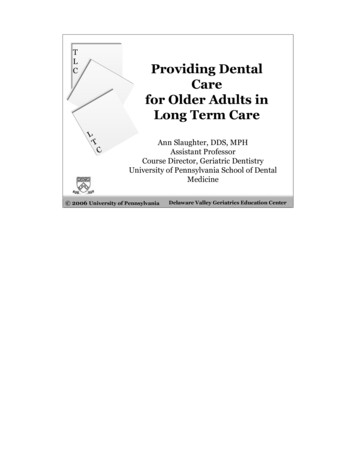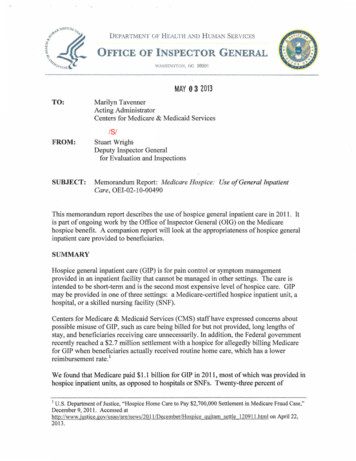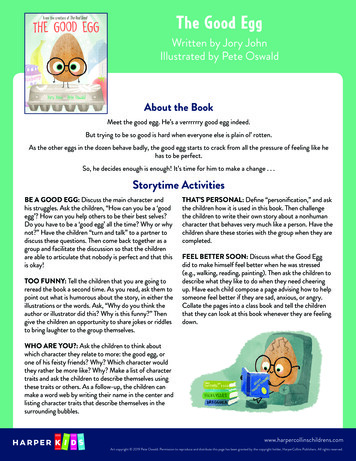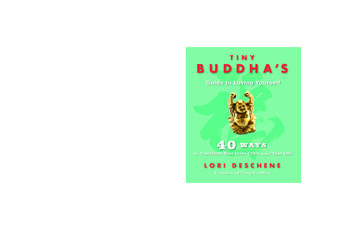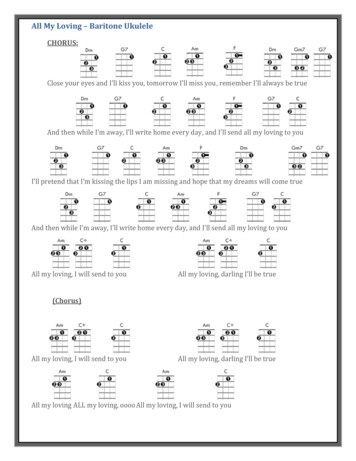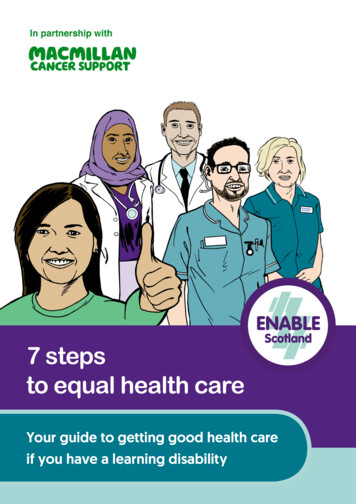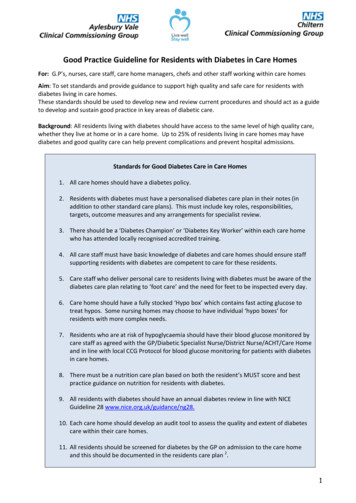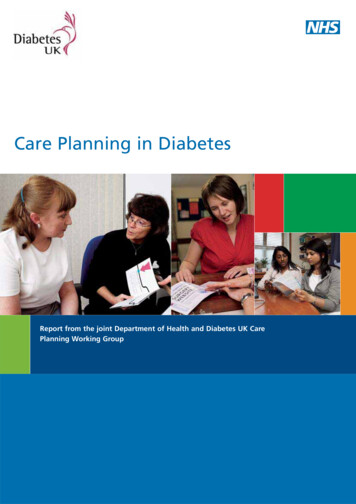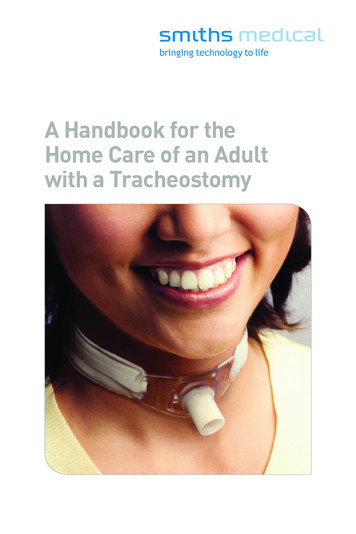
Transcription
Take Good Care ofThis TextbookThis textbook is the property of your school.Take good care not to damage or lose it.IAHIOPOFIC NBLPU ATIOREIC EDUCATOFCRMO STRYNIL DEMIETHere are 10 ideas to help take care of thebook:RADEFE1. Cover the book with protective material, such as plastic, oldnewspapers or magazines.2. Always keep the book in a clean dry place.3. Be sure your hands are clean when you use the book.4. Do not write on the cover or inside pages.5. Use a piece of paper or cardboard as a bookmark.6. Never tear or cut out any pictures or pages.7. Repair any torn pages with paste or tape.8. Pack the book carefully when you place it in your school bag.9. Handle the book with care when passing it to another person.10. When using a new book for the first time, lay it on its back. Openonly a few pages at a time. Press lightly along the bound edge asyou turn the pages. This will keep the cover in good condition.
BIOLOGYSTUDENT TEXTBOOKGRADE 8Authors, Editors and Reviewers:Anteneh Tesfaye(Ph.D)Dereje Mergia (B.Sc, M.A.)Fekadu Worku (M.Sc)Gessesse Assefa (M.Sc)Abebe Getahun(Ph.D)Evaluators:Solomon BelaynehGetachew BogaleGashaw KebedeFEDERAL DEMOCRATIC REPUBLIC OF ETHIOPIAMINISTRY OF EDUCATION
Published E.C. 2004 by the Federal Democratic Republic of Ethiopia, Ministry ofEducation, under the General Education Quality Improvement Project (GEQIP)supported by IDA Credit No. 4535-ET, the Fast Track Initiative Catalytic Fund andthe Governments of Finland, Italy, Netherlands and the United Kingdom. 2012 by the Federal Democratic Republic of Ethiopia, Ministry of Education.All rights reserved. No part of this book may be reproduced, stored in a retrievalsystem or transmitted in any form or by any means including electronic,mechanical, magnetic or other, without prior written permission of the Ministryof Education or licensing in accordance with the Federal Democratic Republicof Ethiopia, Federal Negarit Gazeta, Proclamation No. 410/2004 – Copyright andNeighbouring Rights Protection.The Ministry of Education wishes to thank the many individuals, groups and otherbodies involved – directly and indirectly – in publishing this textbook and theaccompanying teacher guide.Copyrighted materials used by permission of their owners. If you are the owner ofcopyrighted material not cited or improperly cited, please contact with the Ministryof Education, Head Office, Arat Kilo, (PO Box 1367), Addis Ababa, Ethiopia.While every attempt has been made to trace and acknowledge copyright, theauthors and publishers apologies for any accidental infringement where copyrighthas proved untraceable.Developed and Printed bySTAR EDUCATIONAL BOOKS DISTRIBUTORS Pvt. Ltd.24/4800, Bharat Ram Road, Daryaganj,New Delhi – 110002, INDIAandASTER NEGA PUBLISHING ENTERPRISEP.O. Box 21073ADDIS ABABA, ETHIOPIAUnder GEQIP Contract No. ET-MoE/GEQIP/IDA/ICB/G07/09-F.ISBN 978-99944-2-263-0
ContentUnit 1: Biology and Technology11.1Biology for Development1.2Technological products used in Biologyhh Unit summary216hh Review Exercise for Unit 1Unit 2: Cell Biology717212.1Looking at Unicellular Organisms2.2Single Celled Organisms2.3Levels of Cellular Organization in multicellularorganisms38hh Unit summary222548hh Review Exercise for Unit 250Unit 3: Human Biology and Health3.1The reproductive system3.2HIV and AIDS 68hh Unit summary535473hh Review Exercise for Unit 374
IICo n t e n tUnit 4: Plants774.1Food manufacturing in green plants4.2Growing trees87hh Unit summary96hh Review Exercise for Unit 4Unit 5: Animals5.1799699Keeping farm animalshh Unit summary100116hh Review Exercise for Unit 5Unit 6: Environment1171196.1Ecosystem1206.2Biological Associations6.3physical factors of the ecosystemhh Unit summary125130143hh Review Exercise for Unit 6144
Unit1Biology andTechnologyUnit OutcomesBy the end of this unit, you will be able to: explain how biology contributes tocountry’s development; explain the role of technology forthe progress of biology; list at least seven technologicalproducts used in biology; and tell the functions of sometechnological products used inbiology.Main Contents1.1 Biology for Development1.2 Technological Products usedin Biology Unit Review
2Biology Grade 8IntroductionIn your previous grade of biology lessons, you were able to explore the meaning andbranches of biology, industries that utilize biological knowledge and its relevance to society.Furthermore, you have studied biology and technological innovations and values in biologyeducation. In this unit you will identify, discuss and explain how biology contributesdirectly or indirectly in the development of Ethiopia. Biology uses several technologicalproducts. You will explore some of the technological products used in biology.1.1 BiologyforDevelopmentBy the end of this section, you will be able to: explain how biology contributes to the country’s development.Biological studies in general contribute for the development of a country in many aspects.Biology plays a role in the following areas of developmental activity in Ethiopia.Health CareWhat is the contribution of biology for community health?In a community where health conditions are better,people live, safer and longer, reduce incidence ofdiseases, and produce more.Biology is the basis for all health care activities. Inall health care facilities, skilled professionals workin diagnosis, treatment, prevention and control ofdiseases. A wide variety of health care practitionerswork in health care including, medical doctors,nurses, laboratory technicians, etc.Relationship of Biology anddevelopmentBiological knowledge Health Care-Professionals Healthy People Work and Produce more Increased income andstandard of living DEVELOPMENTAll physicians, nurses, laboratory technicians and other health professionals are trainedin the field of biology. These professionals serve in several hospitals, clinics, and otherhealth care centers in Ethiopia.Activity 1.1Discussion on the application of biology in healthProcedure: in group, discuss how the services of clinical laboratory and vaccinationin your community require biological knowledge.55 Present the out comes of your discussion to your class
Unit 1: Biology and Technology3AgricultureWhat is the role of biology in Agriculture?Agriculture plays an important role in theEthiopian Economy. Our country generates itsincome by exporting a number of agriculturalproducts such as coffee, grains, flowers andfruits. Agriculture is an activity of producingcrops and raising animals. Improving qualityof crops and animals needs knowledge ofbiology so that to increase their productivity(See Figure 1.1).Key Terms55Agrochemcials: chemicals usedfor agriculture as fertilizers, weedand pest killers.55Selective breeding: a practice duringwhich selected two individuals mateand produce offspring with improvedqualities.55Hybrid: an individual that has superiorqualities than that found in either ofselected parent.What is the use of Agro-chemicals?Increasing productivity using Agro-chemicals likefertilizers, herbicides (weed-killers), and pesticidesis made possible by using biological principles.However, agro - chemicals can be accumulatedin the body of plants. As plants are consumed byother animals the concentration of these chemicalsincrease by many folds. The accumulation ofthese chemicals in the body of animals includinghumans causes more serious health problems.Agro-chemical residue is the agricultural chemicalfound in the food to be consumed.What is selective breeding?Figure 1.1Improved cropplantation by the useof agrochemicalsSelective breeding of animals is an important practice in which biological knowledge is usedin animal husbandry. Animals with the desired characteristics such as giving more milk,resistance to disease, giving more meat etc. Can be selected and reproduced in large numbers.Selective breeding practices are also conducted to produce plants with desired qualities.Breeding is a practice of selective controlled mating in plants and animals to produceorganisms that better serve human needs for food, work, sport, or aesthetics. Breedinginvolves crossing distinct strains or even species to produce hybrids that contain acombination of traits that is superior to that found in either parent. Hybrid varieties havemany superior qualities, especially in yield and vigor.Genetically modified crops (GM crops) are crops produced by means of genetic engineeringin order to get desired characteristics of crops such as high yield from small plot of land.
4Biology Grade 8Activity 1.2Investigating the role of biology in agricultural productsProcedure:55 in group discuss how agricultural products (egg, milk, crops, hens, cattle)require biological knowledge to increase productivity.55 Present the outcomes of your discussion to the class.Food ProductionWhat is the contribution of biology in food production?The food that we consume is produced by living things; plants and animals. Biologystudies the living things and the processes in the production of nutritional substances(See Figure 1.2). Biology provides the means for keeping quality of foods duringprocessing, transport and storage.Then industrial process, transport and storageof food require biological knowledge to keepquality of foods.Biological studies are essential in determiningnutritional requirements and provision ofnutrition for people.Biologists study the nutritional content of food,as well as the interaction of food componentswith each other, with air, and with packagingmaterials, and the preservation of quality duringprocessing, transporting and storage.Figure 1.2foodssome nutritionalActivity 1.3Discussion on the contribution of biology in food processingProcedure:55 in group, discuss the contribution of biological knowledge in making,transporting and storing biscuits.55 present the outcomes of your discussion to the class.
5Unit 1: Biology and TechnologyImprovemenet of our EnvironmentWhat is the importance of biology for the improvement of our environment?D YK?The conservation of natural environment,id ou nowvegetation, and wildlife is important for our Effective conservation of wildlife and vegetation issurvival. The study of biology contributes toimportant for tourism industry.the improvement of the environment and howhumans can live in harmony with the environment.Good or friendly environmental practices are important to reduce the impact of negative humanactivities on the environment. Good environment is suitable for living. It is a practice throughwhich consumption of natural resources is reduced and introduction of harmful chemicals tothe environment is minimized.Activity 1.4Discussion on the role of biological knowledge in wildlife.Procedure:55 in group, discuss the contribution of biological knowledge to wildlifeconservation55 Role of biological knowledge in tree planting campaign during Ethiopianmillennium.Natural ProductsW is the importance of biology in using natural products (remedies andcosmetics?)Biological knowledge and techniques are also important for production of medicinalsubstances and cosmetics from natural resources. For example, Kosso is used as medicinefor tape worm infection (see Figure 1.3).Activity 1.5Discussion on remedies and cosmeticsProcedure:55 in group, discuss on the economic and biological importance of remediesand cosmetics.
6Biology Grade 8Figure 1.3Hagenia abyssinica (Kosso)tree (left) and its preparation foruse as remedy for tape worm disease(Right).What are natural products and their uses?Cosmetic is a general term applied to allpreparations used externally to conditionand beautify the body. It is done by cleaning,coloring, softening; and used for protectingthe skin, hair, nails, lips and eyes.Natural products used for beauty include:Did You Know?More than 80% of modern medicines are prepared from naturalproducts, mainly from plants.55 “Hinna” used to stain hair55 “Ensosilla” used to stain skinLocal herbal medicines include:55 “Kosso” used to treat Tapeworm.55 “Enkoko” used to treat Tapeworm.55 “Meterae” used to treat Tapeworm and Ascaris.55 “Dingetegna” used to treat sudden illnesses55 “Yemitch medehanit” used to treat common cold and related diseases.Several modern drugs are prepared from plantsand other natural products produced fromplants include:55 Rubber55 Gum55 Incense- “Itan”55 DyesKey Terms55Natural products: are products thatare obtained in nature.55Cosmetics: substances used forbody beauty.55Remedies: substances used fortreatments.
Unit 1: Biology and Technology7Exercise 1.1I1Choose the best answers for the following questionsBiology is used in agriculture to produceAPests attacking plantsCDisease causing plantsBHigh yielding animalsDWeeds2Biological knowledge is needed to improveAFood qualitiesCBFood packagingDFood storageAll of the above3Which of the following biological knowledge is useful to improve the environment?AProtection of vegetationCDamaging natural thingsBDestruction of wildlifeDB and C4The desirable characteristics of plants or animals can be developed for Ethiopianfarmers throughASelective breedingCConservationBNatural breedingDAll of the above5Biological knowledge enables us to know all, but notAThe use of agrochemicalsCThe method of pest control.BThe destruction of naturalDThe method of used controlproducts1.2 Technological Productsused inBiologyAt the end of this section, you will be able to:55 explain the role of technology for theprogress of biology;55 list at least seven technologicalproducts used in biology; and55 tell the functions of some technologicalproducts used in biology.Biological studies use various technologicalproducts. These equipment are products ofother sciences such as Mechanical, Electrical,and Electronic technologies.Some Technological productsused in biological studies: Microscope and hand lens Thermometer Binoculars Stethoscope Sphygmomanometer Incubator Refrigerator and freezer Balances Centrifuges
8Biology Grade 8MicroscopeWhat is Microscope?A microscope is an instrument which is used tostudy smaller objects. It magnifies and revolvesthe object under study. Biologists studysmaller organisms and cells using microscope(Figure 1.4).A Binocular microscopeFigure 1.4Activity 1.6Labelling parts of a microscope1Refer to Grade 7 Biology Unit 1and label the parts of Figure 1.5.2What is the difference between amicroscope and a hand lens?123546791181012Figure 1.5 A microscopeWhat is the use of microscope?Microscopes are tools used to enlarge imagesof small objects so as they can be studied.Microscopes allow us to look at things thatare too small to be seen with our eyes. Themicroscope Figure 1.5 above is the most commontype of microscope, the compound microscope.Compound microscopes can magnify objectsup to about 1,000 times.Word Roots and OriginsThe word microscope is derived from two Greek words“Micro” meaning tiny and “scope” meaning to view orlook at.
9Unit 1: Biology and TechnologyActivity 1.7Observing samples under a MicroscopeMaterials you require:55555555MicroscopeA small cup of yogurt (sample)Slide and cover slipDroppers with teatProcedure:Observation under compound lightmicroscope1Place a drop of thin yogurt at thecenter of the microscope slide andcover it with a cover slip. AvoidFigure 1.6Using the microscopetrapping of air bubbles.2Place the slide at the center over the stage opening on the stage of themicroscope and fix it with clippers.3Adjust the amount of light using the iris diaphragm on the condenser (Figure 1.6).4Focus with the coarse adjustment knob using first the low power objective,and then with medium power objective using the fine adjustment knob toget a clear view.5Observe and search for organisms by moving the slide in all directions, leftto right, and back to forth.6Draw and label what you observe.BinocularKey TermWhat is a Binocular?Field glasses or binocular telescopes areinstruments used to observe distant or farobjects. Binocular is a pair of field glasswhich is made up of two small telescopesjoined with a single focusing device. Itis designed for simultaneous use by botheyes. It allows viewer to use both eyeswhen viewing distant objects (Figure 1.7).55Prism: a block of clear glass whichseparates light in to different colorMain focus(thumbscrew)IndependentfocusOcular lenses(eyepiece)PrismsObjective lensFigure 1.7:A binocular
10Biology Grade 8Activity 1.8Observing distant objects through binocularMaterials you require:55 BinocularProcedure:55 Look first with your naked eyes at the distant object (bird or other animal)55 Use the binocular and look at the same bird or animal you see withyour naked eyes.55 Using the binocular look at sites where you were not able to see clearlywith your eyes.Question:What is the difference between naked eye and binocular observation?Many different abbreviations are used for binoculars, including glasses, binos and bins.ThermometerWhat is a thermometer?It is an instrument used to measure and indicatetemperature. It typically consists of a graduated glasstube that contains mercury or alcohol which expandswhen heated(Figure 1.8).Figure 1.8:ThermometerActivity 1.9Measuring temperature using thermometerMaterial you require:55 Thermometer, 70 % alcohol, cotton, stove, beaker, water.Procedure:55555555Add water to a beaker.Insert a thermometer and measure the temperature.Heat the water on a stove for 10 minutes.Insert a thermometer and read the thermometer.Question:1What was the temperature before and after heating?2What is the difference in temperature between the two?
Unit 1: Biology and Technology11StethoscopeWhat is the use of stethoscope?A stethoscope is a medical instrument used tolisten to sounds produced in the body, especiallyFigure 1.9Stethoscopefrom the heart and lungs. It is designed to be usedwith both ears. It contains two flexible rubberKey Termstubes running from a valve to the ear pieces. Thevalve is connected to the chest piece. The chest 55Heart beat: the rhythmic contractionand relaxation of the heart to pumppiece is either a bell-shaped piece to pick up lowblood through out the body of ansounds or a flat disk for higher frequencies. Mostanimal.stethoscopes have Y-shape (Figure 1.9).55Blood pressure: the pressure ofSphygmomanometercirculating blood from the heart to therest of the body.What is sphygmomanometer?A sphygmomanometer or blood pressure meter is a device usedto measure blood pressure. It is always used in combinationwith a means to determine at what pressure blood flow start andat what pressure it is unimpeded. Manual sphygmomanometersare used together with a stethoscope (Figure 1.10).Figure 1.10SphygmomanometerActivity 1.10Measuring heart beat and bloodpressure.Material you require:55 Stethoscope, SphygmomanometerProcedures:55 With your teacher go to the nearbyclinic and observe how a stethoscopeand Sphygmomanometer are used.Or invite a health worker toyour classroom and ask him/herto demonstrate the use of theseinstruments to you, and55 Record and compare heart beat andblood pressure of the group member.Did You Know? The human heart beats 70 times in average everyminute.
12Biology Grade 8IncubatorWhat is an incubator?Incubator is a device for maintaining anorganism in an environment that encourages itsgrowth (Figure 1.11). The instrument commonlymaintain a constant temperature and, a constanthumidity level in poultry (chicken farm).Incubators are used to keep eggs warm untilthey hatch and to warm the young chicks afterhatching.Figure 1.11IncubatorDid You Know?RefrigeratorAn infant incubator is used to keep pre mature newbornsin a controlled temperature.What is a refrigerator?A refrigerator (often called a “fridge”) is a cooling instrument. It contains a thermallyinsulated compartment and a heat pump to transfer heat from it to the external environment.Then it cools the contents kept in to a temperature below the room temperature.Refrigerators are extensively used to store foods, and prevent bacterial spoilage if thisdevice maintains a temperature a few degrees above the freezing point of water. Asimilar device which maintains a temperature below the freezing point of water is calleda “freezer”. Most freezers operate around 18oC (Figure 1.12).Figure 1.12Refrigerator
Unit 1: Biology and Technology13Activity 1.11Examing food items kept at different incubation conditions.Materials you require:55 Three pieces of meat (fresh),55 Three small plastic containers,55 Freezer refrigerator.Procedure:55 Smell each piece of meat and make sure it is not spoiled (Or they canbe cooked).55 Place one piece in each plastic container.Label:1 Freezer2Refrigerator3Room55 Place label 1, in freezer, label 2 in refrigerator label 3 in one corner ofthe laboratory.55 Each day, smell all of them and return to their places.55 Continue smelling until one of them smells bad.55 Note the day, and continue until the second smells bad.Question:1Which sample goes bad first and after how many days?2Which sample was spoiled next, and after how many days?3Which sample stayed long-unspoiled?4What is your conclusion?BalanceWhat is a balance?A weighing scale (balance) is a measuring instrumentfor determining the weight or mass of an object. Thebalances are used in many industries and laboratoriesto measure the weight or mass of an object or asubstance (Figure 1.13).Specialized medical scales and bathroom scales areused to measure the body weight of human beings.Figure 1.13 Balance
14Biology Grade 8Activity 1.12Measuring weightMaterials you require:55 Bathroom balanceProcedure:5555555555Place the balance on a leveled surface.Adjust the weight indicator to zero by positioning your eyes in 90o line.Without shoe and heavy clothes, mount yourself on the balance.Let other students take the reading (look as above).Compare your weight with the weight of other students.Question:Reading from the side is not correct, why?Activity 1.13Field VisitVisit the nearby health care facility and do the following.1Identify the type of instruments used?2Identify the purpose of each instrument?3Explain how each instrument is used?Present a report of your visit in table format using the following template.Type of InstrumentPurposeHow it is usedCentrifugeWhat is centrifuge?A centrifuge is a device used to separate two or more substance of different mass byrotating at a central axis. It is able to separate different substances from each other becausethe materials with heavier mass moving faster to the bottom of the tube than the lighterone.
Unit 1: Biology and Technology15It is used in industries and scientific laboratories toseparate different substances with different weight ormass (Figure 1.14).Figure 1.14 CentrifugeExercise 1.2Choose the best answers for the following questions.12345Stethoscope is used by physiciansATo listen blood pressureCTo measure tempratureBTo listen heart beatDTo measure weightWhat instrument is used by physicians to measure blood ermometerA centrifuge separates contents from a solution byAHeatingCPressurizingBSpinningDCoolingWhat do you use to measure your body temperature?AAn incubatorBA thermometerDSphyg momanometerCBeam balanceAn incubator is used to controlATemperatureCLightBPressureDGravity
16Biology Grade 8Un i tSu m m a r y Biology plays an important role and contributes for development of ourcountry in community health, agriculture, food production and other usefulaspects. Health professionals that diagnose, treat and cure diseases are trained inbiology. Biological knowledge is needed to increase productivity of crops and animals. Biology plays role in improving the nutritional values of foods. Biology is important to safe guard the environment by providing the ways ofconservation.The following flowchart shows how biological knowledge is related to developmentBIOLOGY FOR DEVELOPMENTBiological KnowledgeHealth CareHEALTHY PEOPLEWork and Produce moreEnvironmentAgricultureBiological KnowledgeFoodNatural ProductsOther activitiesIncreased income and standardof livingDEVELOPMENT
Unit 1: Biology and Technology17 Technological products have played a significant role in the progress ofbiology as science. Microscope is the most important tool used in biology. Other technological products used in biology include centrifuge,thermometer, refrigerator and incubator.Some technological products used in biology are summarized in the following tableTechnological ProductMicroscope and hand lensTo enlarge and see objectsThermometerTo measure temperatureBinocularsTo see far objectsStethoscopeTo listen internal body soundSphygmomanometerTo measure blood pressureIncubatorTo grow or keep at a required temperatureRefrigeratorTo keep materials cold (0-5oC)FreezerTo keep materials cool (below 0oC)BalancesTo measure weightCentrifugesTo separate components in a solution?Ajsjsdf AjsjsdfAjsjsdfAjsjsdfAjsjsdfAjsjsdfAjsjsdfAjsjsdf AjsjsdfAjsjsdfAjsjsdfAjsjsdfAjsjsdfAjsjsdfAjsjsdf AjAjsjsdf AjsjsdfAjsjsdfAjsjsdf AjsjsdfAjsjsdfAjsjsdfAjsjsdfAjsjsdfAjsjsdfAjsjsdf AjsjsdfAjsjsdfAjsjsdfAjsjsdf.AjsjsdfPart I:12Use in BiologyReview Excises for unit 1For the following questions choose the best answer among the choices given.Which one of the following is not the contribution of biology for community healthATracing of health professionalsBProduction of fertilizersCPrevention of diseaseDKnowing causes of diseasesHerbicides are agrochemicals usedATo kill insects attacking cropsBTo fertilize the soilCTo inhibit growth of weedsDTo inhibit growth of crops
18345678Biology Grade 8The agriculture sector develops more when biology plays role inAKeeping soil fertilityBIncreasing plant and animal productivityCthe use of agrochemical productionDAll of the aboveFood production requires biological knowledge toADetermine nutrient contentBImprove food storageCIncrease food productionDAll of the aboveWhich of the following is not a natural product?APlasticBOilCSilkDRubberConsciousness in biology and its application makes environmentASafe to humansBHarmful to humansCUnhealthy to liveDAll of the aboveReproducing plants and animals which have desirable traits is calledAGenetic modificationBFertilizationCSelective breedingDAgrochemical usingA natural product used for colouring hair in Ethiopia isAKossoBEnsosillaCHinnaDMetere
Unit 1: Biology and TechnologyPart II:19Match descriptions in column B with the items in column A lased on functionColumn AColumn B9CentrifugeAused to observe far objects10IncubatorBused to measure blood pressure11StethoscopeCused for growing bacteria12SphygmomanometerDused to heart beat13BinocularEused for spinning materials at high speedPart III:Fill in the blank14The instrument used to know the weight of materials is called15Body temperature is measured by16Health care providers such as17Products used for beauty care are called18Analysis of the Nutrient of food needsPart IV:andare trained in biologyknowledge .Give short Answer19What are the development areas in which biological knowledge is used?20How can biology contribute to the safety of our environment?
20Part V:Biology Grade 8Copy the crossword puzzle and use the numbered clues to complete andsolve the puzzle.12345The numbers in bracket indicates the number of letters in each word.Across1An instrument used for spinning solutions (10)4An instrument used to see very small objects (10)5An instrument used to keep temperature below zero degree centigrade (7)Down ward2An instrument used to measure temperature (11)3An instrument used to listen heart beat (11)
Unit2Cell BiologyUnit OutcomesBy the end of this unit, you will be able to: use hand lenses and microscopes toobserve unicellular organisms andname some unicellular organisms; describe the structure, habitat,locomotion, nutrition, reproductionand importance of some unicellularorganisms; name different types of cells, tissues,organs, and systems and state theirfunctions; describe organism as the highest levelof organization; demonstratescientificenquiryskills: observing, comparing andcontrasting, drawing conclusions,communicating, inferring, problemsolving, comparing and contrasting.Main Contents2.1Looking at UnicellularOrganisms2.2 Single Celled Organisms2.3 Levels of Organization inMulticellular Organisms Unit Review
22Biology Grade 8IntroductionIn Unit 1, you have discussed the contribution of biology to development by its role incommunity health, agriculture, food production, use and conservation of the environment.These contributions of biology for societal development are the outcomes of studying andunderstanding living things or life. Every living thing from the tiniest bacterium to thelargest whale is made of one or more cells. Many of the chemical reactions that keeporganisms alive (metabolic functions) take place in cells.All organisms are made of cells. A cell is the basic unit of structure and function of livingthings. The cell is the smallest unit that carries on all life processes.Unicellular organisms like bacteria, protozoa,algae, and yeasts are organisms that are madeup of one cell. Living organisms such as somealgae, most fungi, plants and animals are madeup of many cells and are called multicellularorganisms. In multicellular organisms all cellswork together and make the organism alive.Did You Know? Unicellular organisms perform thesame life processes as multicellularorganisms. Scientists estimate that our bodiescontain from 75 to 100 trillion(1012 106 X 106) cells.Some of these cells are of the same type andcollectively form a tissue. These cells of a tissuedo the same job. For example, muscle tissues in animals effect movement and vasculartissues in higher plants transport materials.In the following sections you will learn more about different unicellular organisms, whichare very small to be seen with the naked human eye. Thus, you need to use a hand lens ormicroscope to study these organisms.2.
Content Unit 1: Biology and technology 1 1.1 Biology for Development 2 1.2 Technological products used in Biology 7 h Unit summary 16 h Review Exercise for Unit 1 17 Unit 2: cell Biology 21 2.1 Looking at Unicellular Organisms 22 2.2 Single Celled Organisms 25 2.3 Levels of Cellular Organization in multicellular organisms 38 h Unit summary 48 h Review Exercise for Unit 2 50



